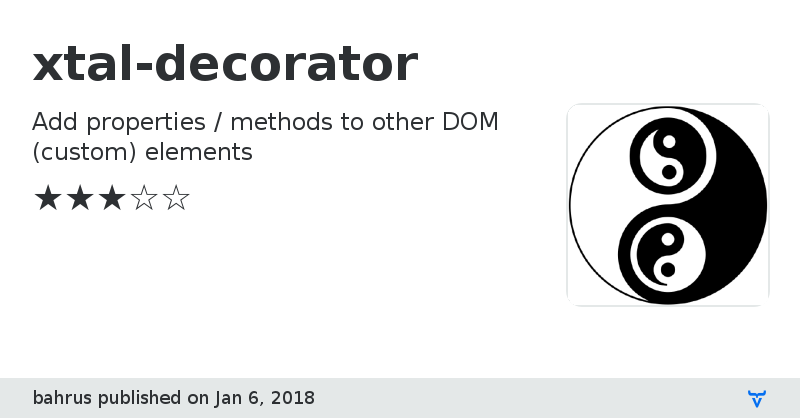xtal-decorator - Vaadin Add-on Directory
Add properties / methods to other DOM (custom) elements

View on GitHub
GitHub Homepage
Documentation
Issue tracker
Online Demo
License
xtal-decorator version 0.0.0
### Dependencies
Polymer/polymer#^2.0.0
xtal-decorator version 0.0.1
### Dependencies
Polymer/polymer#^2.0.0
xtal-decorator version 0.0.2
### Dependencies
Polymer/polymer#^2.0.0
xtal-decorator version 0.0.3
### Dependencies
Polymer/polymer#^2.0.0
xtal-decorator version 0.0.4
### Dependencies
Polymer/polymer#^2.0.0
xtal-decorator version 0.0.5
### Dependencies
Polymer/polymer#^2.0.0
xtal-decorator version 0.0.6
### Dependencies
Polymer/polymer#^2.0.0
xtal-decorator version 0.0.7
### Dependencies
Polymer/polymer#^2.0.0
* PolymerElements/paper-button#^2.0.0
* PolymerElements/paper-input#^2.0.2
xtal-decorator version 0.0.8
### Dependencies
Polymer/polymer#^2.0.0
* PolymerElements/paper-button#^2.0.0
* PolymerElements/paper-input#^2.0.2
xtal-decorator version 0.0.9
### Dependencies
Polymer/polymer#^2.0.0
* PolymerElements/paper-button#^2.0.0
* PolymerElements/paper-input#^2.0.2
xtal-decorator version 0.0.10
### Dependencies
* @bower_components/accessibility-developer-tools#GoogleChrome/accessibility-developer-tools#^2.10.0
* @bower_components/async#caolan/async#^1.5.0
* @bower_components/chai#chaijs/chai#^3.2.0
* @bower_components/font-roboto#PolymerElements/font-roboto#^1
* @bower_components/iron-a11y-announcer#PolymerElements/iron-a11y-announcer#1 - 2
* @bower_components/iron-a11y-keys-behavior#polymerelements/iron-a11y-keys-behavior#1 - 2
* @bower_components/iron-autogrow-textarea#PolymerElements/iron-autogrow-textarea#1 - 2
* @bower_components/iron-behaviors#PolymerElements/iron-behaviors#1 - 2
* @bower_components/iron-checked-element-behavior#PolymerElements/iron-checked-element-behavior#1 - 2
* @bower_components/iron-demo-helpers#PolymerElements/iron-demo-helpers#^2.0.0
* @bower_components/iron-flex-layout#polymerelements/iron-flex-layout#1 - 2
* @bower_components/iron-form-element-behavior#PolymerElements/iron-form-element-behavior#1 - 2
* @bower_components/iron-input#PolymerElements/iron-input#1 - 2
* @bower_components/iron-location#PolymerElements/iron-location#1 - 2
* @bower_components/iron-meta#PolymerElements/iron-meta#1 - 2
* @bower_components/iron-validatable-behavior#PolymerElements/iron-validatable-behavior#1 - 2
* @bower_components/lodash#lodash/lodash#^3.7.0
* @bower_components/marked#chjj/marked#~0.3.6
* @bower_components/marked-element#polymerelements/marked-element#1 - 2
* @bower_components/mocha#mochajs/mocha#^3.1.2
* @bower_components/paper-behaviors#PolymerElements/paper-behaviors#1 - 2
* @bower_components/paper-button#PolymerElements/paper-button#^2.0.0
* @bower_components/paper-input#PolymerElements/paper-input#^2.0.2
* @bower_components/paper-ripple#PolymerElements/paper-ripple#1 - 2
* @bower_components/paper-styles#PolymerElements/paper-styles#1 - 2
* @bower_components/polymer#Polymer/polymer#^2.0.0
* @bower_components/prism#LeaVerou/prism#*
* @bower_components/prism-element#PolymerElements/prism-element#1 - 2
* @bower_components/shadycss#webcomponents/shadycss#^v1.0.0
* @bower_components/sinon-chai#domenic/sinon-chai#^2.7.0
* @bower_components/sinonjs#blittle/sinon.js#^1.14.1
* @bower_components/stacky#PolymerLabs/stacky#^1.3.0
* @bower_components/test-fixture#polymerelements/test-fixture#^3.0.0-rc.1
* @bower_components/web-component-tester#Polymer/web-component-tester#^6.0.0
* @bower_components/webcomponentsjs#webcomponents/webcomponentsjs#^1.0.0
xtal-decorator version 0.0.11
### Dependencies
* @bower_components/accessibility-developer-tools#GoogleChrome/accessibility-developer-tools#^2.10.0
* @bower_components/async#caolan/async#^1.5.0
* @bower_components/chai#chaijs/chai#^3.2.0
* @bower_components/font-roboto#PolymerElements/font-roboto#^1
* @bower_components/iron-a11y-announcer#PolymerElements/iron-a11y-announcer#1 - 2
* @bower_components/iron-a11y-keys-behavior#polymerelements/iron-a11y-keys-behavior#1 - 2
* @bower_components/iron-autogrow-textarea#PolymerElements/iron-autogrow-textarea#1 - 2
* @bower_components/iron-behaviors#PolymerElements/iron-behaviors#1 - 2
* @bower_components/iron-checked-element-behavior#PolymerElements/iron-checked-element-behavior#1 - 2
* @bower_components/iron-demo-helpers#PolymerElements/iron-demo-helpers#^2.0.0
* @bower_components/iron-flex-layout#polymerelements/iron-flex-layout#1 - 2
* @bower_components/iron-form-element-behavior#PolymerElements/iron-form-element-behavior#1 - 2
* @bower_components/iron-input#PolymerElements/iron-input#1 - 2
* @bower_components/iron-location#PolymerElements/iron-location#1 - 2
* @bower_components/iron-meta#PolymerElements/iron-meta#1 - 2
* @bower_components/iron-validatable-behavior#PolymerElements/iron-validatable-behavior#1 - 2
* @bower_components/lodash#lodash/lodash#^3.7.0
* @bower_components/marked#chjj/marked#~0.3.6
* @bower_components/marked-element#polymerelements/marked-element#1 - 2
* @bower_components/mocha#mochajs/mocha#^3.1.2
* @bower_components/paper-behaviors#PolymerElements/paper-behaviors#1 - 2
* @bower_components/paper-button#PolymerElements/paper-button#^2.0.0
* @bower_components/paper-input#PolymerElements/paper-input#^2.0.2
* @bower_components/paper-ripple#PolymerElements/paper-ripple#1 - 2
* @bower_components/paper-styles#PolymerElements/paper-styles#1 - 2
* @bower_components/polymer#Polymer/polymer#^2.0.0
* @bower_components/prism#LeaVerou/prism#*
* @bower_components/prism-element#PolymerElements/prism-element#1 - 2
* @bower_components/shadycss#webcomponents/shadycss#^v1.0.0
* @bower_components/sinon-chai#domenic/sinon-chai#^2.7.0
* @bower_components/sinonjs#blittle/sinon.js#^1.14.1
* @bower_components/stacky#PolymerLabs/stacky#^1.3.0
* @bower_components/test-fixture#polymerelements/test-fixture#^3.0.0-rc.1
* @bower_components/web-component-tester#Polymer/web-component-tester#^6.0.0
* @bower_components/webcomponentsjs#webcomponents/webcomponentsjs#^1.0.0
xtal-decorator version 0.0.12
### Dependencies
* @bower_components/accessibility-developer-tools#GoogleChrome/accessibility-developer-tools#^2.10.0
* @bower_components/async#caolan/async#^1.5.0
* @bower_components/chai#chaijs/chai#^3.2.0
* @bower_components/font-roboto#PolymerElements/font-roboto#^1
* @bower_components/iron-a11y-announcer#PolymerElements/iron-a11y-announcer#1 - 2
* @bower_components/iron-a11y-keys-behavior#polymerelements/iron-a11y-keys-behavior#1 - 2
* @bower_components/iron-autogrow-textarea#PolymerElements/iron-autogrow-textarea#1 - 2
* @bower_components/iron-behaviors#PolymerElements/iron-behaviors#1 - 2
* @bower_components/iron-checked-element-behavior#PolymerElements/iron-checked-element-behavior#1 - 2
* @bower_components/iron-demo-helpers#PolymerElements/iron-demo-helpers#^2.0.0
* @bower_components/iron-flex-layout#polymerelements/iron-flex-layout#1 - 2
* @bower_components/iron-form-element-behavior#PolymerElements/iron-form-element-behavior#1 - 2
* @bower_components/iron-input#PolymerElements/iron-input#1 - 2
* @bower_components/iron-location#PolymerElements/iron-location#1 - 2
* @bower_components/iron-meta#PolymerElements/iron-meta#1 - 2
* @bower_components/iron-validatable-behavior#PolymerElements/iron-validatable-behavior#1 - 2
* @bower_components/lodash#lodash/lodash#^3.7.0
* @bower_components/marked#chjj/marked#~0.3.6
* @bower_components/marked-element#polymerelements/marked-element#1 - 2
* @bower_components/mocha#mochajs/mocha#^3.1.2
* @bower_components/paper-behaviors#PolymerElements/paper-behaviors#1 - 2
* @bower_components/paper-button#PolymerElements/paper-button#^2.0.0
* @bower_components/paper-input#PolymerElements/paper-input#^2.0.2
* @bower_components/paper-ripple#PolymerElements/paper-ripple#1 - 2
* @bower_components/paper-styles#PolymerElements/paper-styles#1 - 2
* @bower_components/polymer#Polymer/polymer#^2.0.0
* @bower_components/prism#LeaVerou/prism#*
* @bower_components/prism-element#PolymerElements/prism-element#1 - 2
* @bower_components/shadycss#webcomponents/shadycss#^v1.0.0
* @bower_components/sinon-chai#domenic/sinon-chai#^2.7.0
* @bower_components/sinonjs#blittle/sinon.js#^1.14.1
* @bower_components/stacky#PolymerLabs/stacky#^1.3.0
* @bower_components/test-fixture#polymerelements/test-fixture#^3.0.0-rc.1
* @bower_components/web-component-tester#Polymer/web-component-tester#^6.0.0
* @bower_components/webcomponentsjs#webcomponents/webcomponentsjs#^1.0.0
xtal-decorator version 0.0.13
### Dependencies
* @polymer/polymer#^3.0.0
xtal-decorator version 0.0.14
### Dependencies
* xtal-latx#0.0.18
xtal-decorator version 0.0.15
### Dependencies
* xtal-latx#0.0.18
xtal-decorator version 0.0.16
### Dependencies
* xtal-latx#0.0.18
* xtal-shell#0.0.10
xtal-decorator version 0.0.17
### Dependencies
* xtal-latx#0.0.18
* xtal-shell#0.0.10
xtal-decorator version 0.0.18
### Dependencies
* xtal-latx#0.0.18
* xtal-shell#0.0.10
xtal-decorator version 0.0.19
### Dependencies
* xtal-latx#0.0.18
* xtal-shell#0.0.10
xtal-decorator version 0.0.20
### Dependencies
* xtal-latx#0.0.19
* xtal-shell#0.0.10
xtal-decorator version 0.0.21
### Dependencies
* xtal-latx#0.0.19
* xtal-shell#0.0.10
xtal-decorator version 0.0.22
### Dependencies
* xtal-latx#0.0.22
* xtal-shell#0.0.10
xtal-decorator version 0.0.23
### Dependencies
* xtal-latx#0.0.24
* xtal-shell#0.0.10
xtal-decorator version 0.0.24
### Dependencies
* xtal-latx#0.0.24
* xtal-shell#0.0.10
xtal-decorator version 0.0.25
### Dependencies
* xtal-latx#0.0.26
* xtal-shell#0.0.10
xtal-decorator version 0.0.26
### Dependencies
* xtal-latx#0.0.26
* xtal-shell#0.0.10
xtal-decorator version 0.0.27
### Dependencies
* xtal-latx#0.0.26
* xtal-shell#0.0.10
xtal-decorator version 0.0.29
### Dependencies
* xtal-latx#0.0.47
* xtal-shell#0.0.10
xtal-decorator version 0.0.30
### Dependencies
* xtal-latx#0.0.76
* xtal-shell#0.0.10
xtal-decorator version 0.0.31
### Dependencies
* xtal-latx#0.0.76
* xtal-shell#0.0.10
xtal-decorator version 0.0.32
### Dependencies
* xtal-latx#0.0.76
* xtal-shell#0.0.10
xtal-decorator version 0.0.33
### Dependencies
* xtal-latx#0.0.76
* xtal-shell#0.0.10
xtal-decorator version 0.0.34
### Dependencies
* xtal-latx#0.0.88
* xtal-shell#0.0.18
* trans-render#0.0.68
xtal-decorator version 0.0.35
### Dependencies
* xtal-latx#0.0.88
* xtal-shell#0.0.18
* trans-render#0.0.68
xtal-decorator version 0.0.36
### Dependencies
* xtal-latx#0.0.88
* xtal-shell#0.0.18
* trans-render#0.0.68
xtal-decorator version 0.0.37
### Dependencies
* xtal-latx#0.0.88
* xtal-shell#0.0.18
* trans-render#0.0.68
xtal-decorator version 0.0.38
### Dependencies
* xtal-latx#0.0.88
* xtal-shell#0.0.18
* trans-render#0.0.68
xtal-decorator version 0.0.39
### Dependencies
* xtal-latx#0.0.88
* xtal-shell#0.0.18
* trans-render#0.0.68
xtal-decorator version 0.0.40
### Dependencies
* trans-render#0.0.78
* xtal-element#0.0.29
* xtal-shell#0.0.18
xtal-decorator version 0.0.41
### Dependencies
* trans-render#0.0.78
* xtal-element#0.0.29
* xtal-shell#0.0.18
xtal-decorator version 0.0.42
### Dependencies
* trans-render#0.0.94
* xtal-element#0.0.42
* xtal-shell#0.0.18